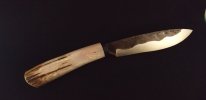- Joined
- Aug 3, 2011
- Messages
- 46
Hey Guys,
I have checked past threads and google and I can't seem to find this specific question, or the answer so such. My sister is about to get married and I am making a kitchen knife for her and a sailing or riggers knife for my soon to be brother in law (due to the fact that he sails) I had some stainless that I had it made out of, but I then proceeded to destroy it during the HT (yay me) I am now down to the wire with no time left to order another piece of stainless. So, on to my question. What is the best way to make 1084 as corrosion resistant as it can be. Cold Blueing, leave the forge scale on, FC etching? I just don't know. Any help would be greatly appreciated!
Thank you guys.
I have checked past threads and google and I can't seem to find this specific question, or the answer so such. My sister is about to get married and I am making a kitchen knife for her and a sailing or riggers knife for my soon to be brother in law (due to the fact that he sails) I had some stainless that I had it made out of, but I then proceeded to destroy it during the HT (yay me) I am now down to the wire with no time left to order another piece of stainless. So, on to my question. What is the best way to make 1084 as corrosion resistant as it can be. Cold Blueing, leave the forge scale on, FC etching? I just don't know. Any help would be greatly appreciated!
Thank you guys.





